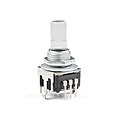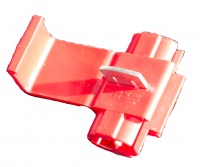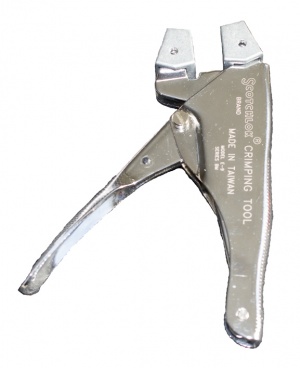Electrical Devices
Summary: Electrical Devices are various components used for the control and consumption of electrical power. Examples include switches, lamp sockets and outlets.
Working with high voltages, such as your house's electrical system, is dangerous. For high voltage work contact a qualified technician to do the work for your own safety.
For DCC, we would be interested in the various wiring devices, such as switches, Marrettes, and associated items used to connect your track to the power source. With DCC these will be used for low voltage (less than 48V) circuits
Devices
Devices is the term used in the Electrical Code. We will also use this term for a similar purpose.
Various Types of Electrical Devices
Switches
These are for routing electricity, not trains.
There are many kinds, from the familiar toggle switch to more specialized types, such as rotary switches.
Nomenclature: Switches are often denoted by the number of throws, and number of poles. They will also be specified as Make before Break, or Break before Make. Typically, they will break the connection prior to making the new connection.
SPST
Single Pole Single Throw. This would be familiar as an ON/OFF switch.
SPDT
Single Pole Double Throw. This switch can also be used as an ON/OFF, but it disconnects both wires instead of just one as a SPST would.
DPST
Double Pole Single Throw. This switch can toggle from one circuit to another. A common example would be the switches used to control a light from two positions, such as at either end of a hall. Depending on the alignment of the switches, the lamp will be on or off. The switch that controls your car's high beams would also be an example if you only have a pair of high/low headlights. If you have a four lamp setup, it would use a DPST and SPST in the same package. The DPST selects which filament is energized.
DPDT
Double Pole, Double Throw. Same idea as the SPDT, except there is an additional pair of poles. They can be used to select a circuit, such as Speaker A or B, or Input A or B. A common application in model railroading would be to select one of two cabs connected to a block, or by correct wiring, used to control direction.
(X)PDT (X)PST
As with the above, you can have a number replace the X. You can have various combinations, from 3P or 4P, or even more. As you add more poles, the cost increases rapidly.
A common application would be the 4PDT used with a programming track
Center OFF, Momentary
Some switches are built to have a third position, where there are no connections made. The switch would be described as ON-OFF-ON, instead of ON-ON. Typically, the center position is OFF.
Momentary switches are spring loaded, so once the force is removed the switch returns to its normal position. These are used for twin coil switch machines or solenoids. The coils will burn out if power is constantly applied to them.
NO, NC
These terms mean Normally Open or Normally Closed. These switches are momentary in nature, where a spring returns the switch contacts to their normal position when the force applied is removed. A typical NC application is the brake switch in your car. Depressing the pedal removes the force holding the switch open, and the lights come on as the internal spring pushes the contacts into their closed position. When the brake is released, the pedal is pulled back to its normal resting position, and the lever pushes against the button on the switch and opens the circuit, de-energizing the brake lights. Simple yet effective.
A NO switch would be those on the keyboard of your computer. Pressing a key completes the circuit, releasing the key allows the spring to return to its normal position and open the circuit.
Make and Break
These terms are used with switches. Often the description with specify Make before Break or Break before Make. This indicates the action of the switch, does it break the first connection before making the second one, or are both connections made before the first one is broken?
For most DCC applications, a Break before Make type is preferred. Especially if you are wiring a program track. This type of switch ensures that the booster's track bus and programming outputs are not connected together when the switch is thrown. If being used in reverse loop situation, it prevents the two phases from being shorted together.
Rotary
A rotary switch rotates instead of toggling. They can be used to select multiple circuits and route power/signals in complex ways. They may have one deck, they may have multiple decks, depending on the application. Older audio equipment such as receivers would have rotary switches to select the AM or FM section and connect it to the amplifier, route the phono input into the preamp and from there to the amplifier, or disconnect the phono input and connect the AUX input. The switch is wired in such a way that only one circuit can be connected at any time, all others are disconnected.
An application with model railroading would be to select one of several cabs and connect it to a block. Or to set a turnout and route power.
A similar type of switch would be a ganged pushbutton switch, where only one can be depressed, pressing another mechanically releases the switch before the button you pressed latches.
Encoder
An encoder is a type of rotary switch, but it has multiple outputs. The outputs form a binary value, which changes as the knob is rotated. Many DCC throttles use encoders to control the speed. Turning them causes the binary value on the output to increase or decrease. Much easier to interface to a microprocessor than a potentiometer found in an analog cab.
A rotary encoder's output is in Gray Code, making de-bouncing easier as only one value can change. Software can then determine not only what the value is, but in which direction the knob is being turned.
Connection Methods
While not devices in the true sense, these products enable you to easily and reliably connect two or more wires together. Without soldering.
Marrettes
The generic name for a Marrette is a twist on connector. They are named for the inventor, George Marr. (The term Wire-Nut is also a trademark.)
The common form of Marrette is a plastic cap with a wire coil of spring steel inside. Two are more conductors are stripped and lightly twisted together. The Marrette is pushed onto the conductors and twisted. The coil bites into the soft copper and mechanically secures the wires together. They are very reliable and used in electrical wiring everywhere. They also work with stranded wire.
They replace terminal strips and soldered splices. They can also be removed for later rework. Twist on connectors are available from a number of companies, and come in a variety of colours which indicate the gauge of wire they are designed to work with.
Insulation Displacement Connectors
IDCs, also known as ScotchLoks (made by 3M) can connect two wires together. The device has two channels, one passes completely through the device, the other is blind. The main bus would pass through, and the feeder would be tapped off in the blind channel.
Once the wires are in place, a special pair of pliers is used to press a metal blade into the wires. The connection is made by slicing through the insulation on both wires. The blade has two openings so only the insulation is cut, not the conductor.
The pliers used have jaws that move in parallel to each other, so the crush force is evenly distributed. After the blade has been pushed into the body to make the connection, a plastic cover is snapped down over the blade to protect the connection and hold the two halves of the body together. The appearance earned the IDC connector the nickname "suitcase" connector.
Please note that there are many knock-offs of the original ScotchLok design, some are good, others are much cheaper and not as good.
ScotchLoks come in a number of colours, which indicate the gauge(s) of wire it can accommodate.
Another variety of Scotchloks are Tap Connectors, which are similar in nature. You crimp the Scotchlok onto the bus wire, and the secondary connection is made using a quarter inch (0.25") tab type connector inserted into a mating slot. This allows connection and disconnection easily.
Anderson Power Poles
The Power Poles are made by Anderson Power Products, and are already a de facto standard in the RC modeller world. NTrak also endorses their usage. Male and female connectors are made, which make connecting power to modules, etc., easy.
Crimp On Terminations
Crimping is an efficient and highly reliable method to assemble and terminate conductors, and typically provides a stronger, more reliable termination method than that achieved by soldering. The process of compressing and reshaping the terminal cold welds it to the wire.
Terminations, or lugs, can be crimped onto stranded wire. The barrel of the termination is placed over the end of a stripped wire and crimped using crimping pliers designed for the purpose. The result is a mechanically secure gas tight connection. Terminations are available in a number of sizes, for a variety of wire gauges, in the form of rings, forks, or spades. The application determines the type of termination. Forked terminals can be mated using a terminal strip. There are also pin and flat tongue types, which would be used with terminal blocks such as those found on Digitrax command stations.
Insulated Crimp On Terminations
With insulated terminals the better-quality connectors have a metal sleeve to grip the wire insulation, lower quality parts do not have this. Look down the barrel of the crimp from the wire entry end. You will see metal almost to the end of the crimp in a quality part, but it will stop short in cheaper parts.
All terminals are sold with defined wire size ranges. Insulated ones can be identified by the colour of the sleeve. Typical sizes are:
- Red: 22-16 AWG (0.5-1.5mm2)
- Blue: 16-14 AWG (1.5-2.5mm2)
- Yellow: 12-10 AWG (4.0-6.0mm2)
For layout wiring, bus wiring will use yellow or blue connectors, while feeders to the rails would typically be the smaller gauge red colour sleeves.
Insulated terminals are best crimped with a specialized tool designed for the purpose. They are not cheap. The crimper has three colour coded dies that match the insulating sleeve's colour, which results in a much better crimp than that done with a simple pair of pliers.
Uninsulated terminals are also available, often through electrical suppliers in bulk quantities (i.e. 1000 pcs per box). They can be crimped easily with a proper crimping plier. While a specialized set of pliers is needed, they are much less costly than the crimpers designed for insulated terminals.
Do I Need to Solder Crimped Connections?
Soldering actually reduces the reliability of the crimp. Crimps are designed to control the flexure of cable at the entry point. Soldering can stiffen the joint and result in premature failure. The solder will wick up under the insulation creating a stiff section of wire, and the strands can break at the boundary between flexing and stiff wire.
In fact, crimping results in a gas-tight connection so the solder cannot penetrate the barrel, as there is no place for it to go. Do not tin the wire before crimping, as this limits the ability to create a gas tight connection. The strands of wire have to move to fill all the gaps so cold welding can take place. The result is a connection which is often stronger mechanically than a soldered connection.
- NASA workmanship standards prohibit crimping on tinned wires. NASA also prohibits soldering after crimping.
Tips for Crimping
- Purchase good quality crimp terminals
- Avoid damaging the wire when stripping it
- Crimp matched to the wire size
- Use a good quality ratchet crimping tool
- Do not solder the crimp
- Do not tin the wire before crimping
- Use heat shrink tubing if needed to provide strain relief or additional insulation
Terminal or Barrier Strip
Terminal blocks (or strips) provide a convenient means of connecting individual electrical wires without a splice or physically joining the ends. Since terminal blocks are readily available for a wide range of wire sizes and terminal quantity, they are one of the most flexible types of electrical connector available. One type of terminal block accepts wires that are prepared only by stripping a short length of insulation from the end. Another type, often called barrier strips, accepts wires that have ring or spade terminal lugs crimped onto the wires.
The same rules apply to terminal strips as they do to crimped on terminals: Do not tin the wires. The ability to crush the wire with the clamping force of the screw makes for a secure, gas-tight connection.
Metal "combs" are also available, which allow you to bridge several terminals, making distribution of power from one connection to a number of connections possible.
DIN Rail
Barrier strips are also available in the DIN Rail format, allowing custom blocks to be created by clipping them onto the rail.
Push On Connectors
Made for solid and stranded wire, after stripping the insulation the conductor is inserted into a hole and pushed in. A spring inside makes it difficult to remove the wire later. The connector will often have three positions, two or three wires can be connected using this device.
There must be more…
If you know of additional devices which make layout wiring easier, please add them.
External Sites
Scotchloks / Insulation Displacement Connectors
3M has a lot of information on their products available online.
For information on Scotchloks: Scotchlok IDC Connectors Scotchlok IDC Brochure
- Tap Connector Data Sheet
- Scotchlok Data Sheet
- Scotchlok 3M™ Scotchlok IDC Connectors for Electrical Applications
These pages will provide you with information on the 3M IDC products available, so you can make an informed choice. Follow the instructions for reliable usage on your layout.
These devices can be purchased from vendors such as Micro Mark, Digikey, and other suppliers, in small or large quantities. Often you will not find the more esoteric versions at your local hardware store or electrical supplier.
Anderson Power Pole Connectors:
They make a variety of connectors for almost any use.
Crimping
- http://tooling.te.com/pdf/US_crimpposter.pdf
- http://tooling.te.com/europe/pdf/crimp-connections-english-german-3-1773444-1.pdf
- http://www.molex.com/pdm_docs/ats/TM-638000029.pdf
- http://www.molex.com/pdm_docs/ats/TM-640160065.pdf
- Crimping Tools and the Cost of being Cheap
Further Reading
- A ROTARY ENCODER: HOW HARD CAN IT BE? More on rotary encoders and how they work.








